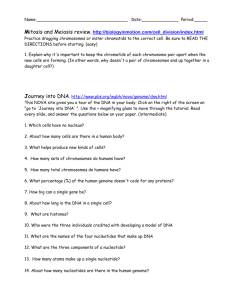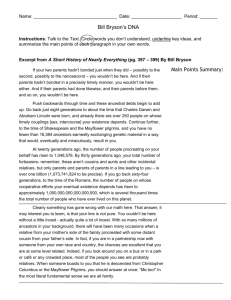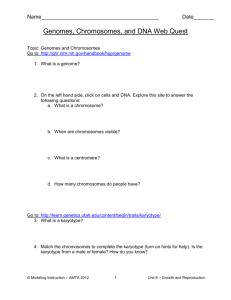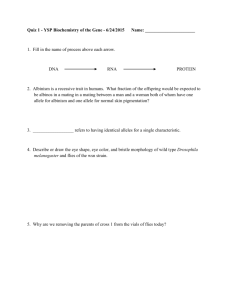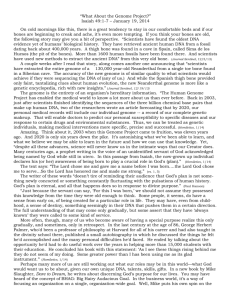3687317_mlbio10_Ch14_TestA_3rd.indd
advertisement
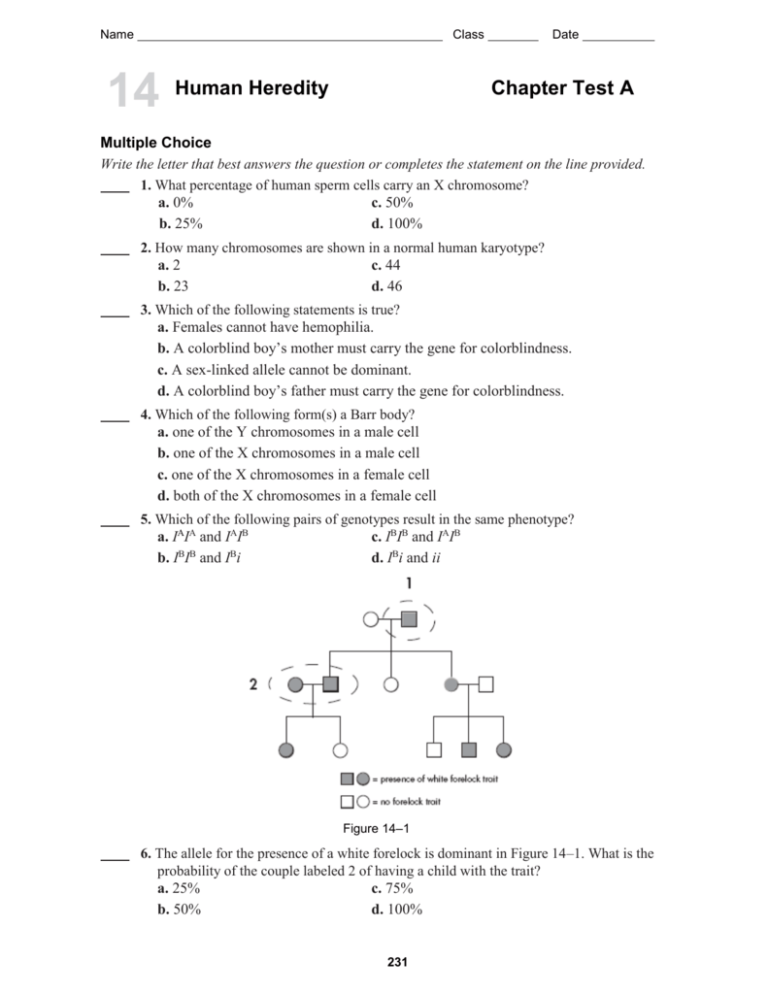
Name Class 14 Human Heredity Date Chapter Test A Multiple Choice Write the letter that best answers the question or completes the statement on the line provided. 1. What percentage of human sperm cells carry an X chromosome? a. 0% c. 50% b. 25% d. 100% 2. How many chromosomes are shown in a normal human karyotype? a. 2 c. 44 b. 23 d. 46 3. Which of the following statements is true? a. Females cannot have hemophilia. b. A colorblind boy’s mother must carry the gene for colorblindness. c. A sex-linked allele cannot be dominant. d. A colorblind boy’s father must carry the gene for colorblindness. 4. Which of the following form(s) a Barr body? a. one of the Y chromosomes in a male cell b. one of the X chromosomes in a male cell c. one of the X chromosomes in a female cell d. both of the X chromosomes in a female cell 5. Which of the following pairs of genotypes result in the same phenotype? a. IAIA and IAIB c. IBIB and IAIB b. IBIB and IBi d. IBi and ii Figure 14–1 6. The allele for the presence of a white forelock is dominant in Figure 14–1. What is the probability of the couple labeled 2 of having a child with the trait? a. 25% c. 75% b. 50% d. 100% 231 Name Class Date Figure 14–2 7. How many generations are shown in Figure 14–2? a. 2 b. 4 c. 6 d. 8 8. Compared with normal hemoglobin, the hemoglobin of a person with sickle cell disease is a. longer. c. less soluble. b. shorter. d. more soluble. 9. People who are heterozygous for sickle cell disease are generally healthy because they a. are resistant to many different diseases. b. have some normal hemoglobin in their red blood cells. c. are not affected by the gene until they are elderly. d. produce more hemoglobin than they need. 10. If nondisjunction occurs during meiosis, a. only two gametes may form instead of four. b. some gametes may have an extra copy of some genes. c. the gamete cannot join another to form an organism. d. the gametes redistribute chromosomes after meiosis. 11. Which piece of DNA would move fastest in gel electrophoresis? A segment that is a. 100 base pairs long. c. 5,000 base pairs long. b. 1,000 base pairs long. d. 100,000 base pairs long. 12. What is the role of restriction enzymes in studying the human genome? a. copying pieces of DNA b. labeling different nucleotides with different colors of dyes c. separating different pieces of DNA based on their size d. cutting large DNA molecules into smaller pieces 232 Name Class Date Figure 14–3 13. Which enzyme(s) in Figure 14–3 would be best for making fragments with sticky ends? a. EcoRI and HaeIII c. HaeIII alone b. HaeIII and BamI d. EcoRI and BamI 14. What did scientists in the Human Genome Project look for in DNA to identify the locations of genes? a. promoters c. CFTR b. sex-linked genes d. autosomes 15. Why is it helpful to sequence many human genomes, instead of just one? a. Scientists can confirm that everyone’s genome is identical. b. Scientists can find how the human genome varies. c. Scientists can find out how to get rid of viral DNA from our cells. d. Scientists can provide insurance companies with everyone’s genome. Completion Complete each statement on the line provided. 16. A boy who is colorblind inherited the disorder from his ____________________. 17. A(An) ____________________ is a diagram that follows the inheritance of a single gene through several generations of a family. 18. A female with the disorder _________________________ inherits only one X chromosome. 19. The law that protects people from being discriminated against because of information learned in genetic tests is called the __________________________. Answers - Chapter 14 —Test A Multiple Choice 1. c 2. d 3. b 4. c 5. b 6. c 7. b 8. c 9. b 10. b 11. a 12. d 13. d 14. a 15. b Completion 16. mother 17. pedigree 18. Turner’s syndrome 19. Genetic Information Nondiscrimination Act
